Introduction
The Nikon D7000 is a new prosumer DSLR camera with a 16.2-megapixel DX-format image sensor. Key highlights of the D7000 include Full 1080p HD video with full-time autofocus and manual exposure control, an ISO range of 100-25600, the widest of any Nikon DX camera, a new 2,016-pixel 3D Colour Matrix metering system, new EXPEED 2 image-processing engine, new 39-point Auto-focus system with 3D tracking, 14-bit analogue-to-digital conversion, 6fps continuous shooting, dust- and moisture-sealed magnesium alloy body, 921k dot 3-inch LCD screen, and dual memory card slots. The Nikon D7000 costs £1099.99/ $1199.95 for body only and £1299.99 / $1499.95 for the body and the AF-S DX Zoom-Nikkor 18-105mm f/3.5-5.6G ED VR kit lens.
Ease of Use
The new Nikon D7000 slots in between the existing D90 and D300s models, not only in terms of feature set and functionality, but also in terms of size and weight. It isn't as compact and lightweight as the D90 but neither is it quite as bulky and heavy as the D300s. The right-hand grip bears more resemblance to that of the D300s, with a chunkier rubberised coating than on the D90. There's also a rubberised thumb rest on the back of the body.
The 18-105mm f/3.5-5.6G ED VR kit lens that ships with the D7000 feels well-balanced on the Nikon D7000 and despite only having a plastic mount it fits into place with a reassuring mechanical click. It also adds the very important advantage of Vibration Reduction. Nikon bodies don't offer any form of in-camera image stabilisation, unlike similar models from Sony, Pentax and Olympus, so the relatively affordable and versatile 18-105mm VR lens is a good starting point if you don't already have any Nikon lenses.
The shutter release action on the Nikon D7000 is surprisingly quiet, with an exemplarily dampened mirror slap that makes this DSLR actually quieter than some rangefinder cameras, and it's tested for 150,000 cycles. Furthermore, there is also a Quiet mode, in which the mirror is raised fairly slowly to further reduce the sound it makes. This, however, introduces some shutter lag, which usually isn't worth the few decibels of difference versus what is already an impressively quiet shutter (Nikon actually recommends using the Quiet mode for taking pictures of sleeping babies, a situation in which a bit of shutter delay obviously isn't a problem).
The overall control layout and 'philosophy' of the Nikon D7000 is very similar to the D90, with two control wheels and dedicated buttons for controlling ISO sensitivity, white balance, metering and AF mode. Only the combined Live View switch and Movie Mode button and lockable drive mode dial are completely new, with the former being an improvement on the D90 but the latter being somewhat awkward, requiring the use of both fore- and middle fingers. In addition the Playback button has moved to the left of the viewfinder in line with models higher up the range. This all means that upgrading from the D90 to the D7000 is a near seamless experience from a handling point of view.
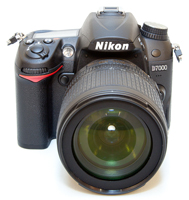 | 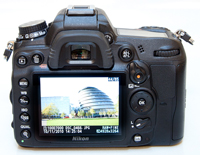 |
| Front | Rear |
The D7000 uses a new EN-EL15 battery, MH-25 recharger and MB-D11 battery grip, which improves the handling but doesn't speed up the camera in any way. The D7000 records images on SD/SDHC/SDHC cards via not one but two slots housed in the large right-hand compartment. This allows you to use two cards in tandem, with the ability to overflow images onto the second card, backup images from the first to the second, or save RAW to slot 1 and JPEG to slot 2. It also obviously greatly expands the overall memory capacity, useful if you shoot a lot of images in a short space of time.
The Nikon D7000 follows conventional DSLR design in having a shooting mode dial on the top of the camera, which allows you to select either one of the advanced modes like Manual, Aperture- or Shutter-priority, or 19 different scene modes. The Exposure Compensation button is thoughtfully positioned next to the shutter release. Hold down this button with your right forefinger and spin the control wheel on the top-rear of the camera with your thumb to adjust its settings - simple and intuitive. The other button sitting next to the shutter release is for setting the metering. The D7000 has a similar monochromatic status LCD to the D90, a pro-level feature that indicates who this camera is primarily targeted at. On cheaper cameras, the LCD on the rear usually has to do both jobs, but on this model most of the key settings are visible from above on the smaller panel. This can make the Nikon D7000 quicker to use and it may also extend the battery life, depending on how extensively you use the rear LCD screen.
The D90's 12 megapixel CMOS sensor has been superseded by a 16.2 megapixel CMOS chip (the same sensor as used in the Sony A55), capable of providing a Live View feed, recording Full HD video and capturing full-resolution stills at 6 frames per second for up to JPEG 100 images, up from 4.5fps in the D90. There's also a a Continuous Lo shooting option (1-5fps). The sensor can clean itself by way of high-frequency vibrations that will, at least in theory, shake off any non-adhesive dust particles that may have settled on the low-pass filter during a lens change. You can specify, via an option in the Setup menu, whether you want sensor cleaning to take place at shutdown, startup, both or neither, with the default being 'both'. The cleaning process pleasingly has no practical impact on startup times, which were near instant. The new image sensor is complemented by the more powerful EXPEED 2 processing engine and a larger buffer as well.
The D7000 inherits the same excellent three-inch, 920,000-dot monitor as the D90. The screen is used not only to navigate menus and to review pictures, but can also act as a secondary status display, facilitating the transition for upgraders from entry-level DSLR owners who are not used to having a top-mounted status LCD on their cameras. It's also the rear screen that provides live view for capturing both stills and movies. For this reason, we were a little disappointed that the monitor was fixed, lacking articulation of any kind, something that one of the D7000's key rivals, the Canon EOS 60D, does offer.
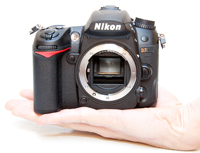 | 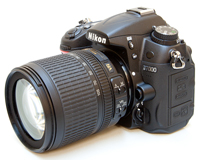 |
| Front |
Side
|
You still get a true optical TTL finder as well though, and it's an excellent to boot. The key difference between the D90's and the D7000's finders is the frame coverage, with the former at 96% and the latter at an impressive 100%. The auto-focus system has also been significantly upgraded, with the centre point permanently marked on the focusing screen the other 38 points lighting up as red boxes, and compositional grid lines that can be called up via a menu option. Three warning signs – reminding you that you are in black-and-white capture mode, the battery is running low or you have forgotten to insert a memory card – may also appear in the form of overlaid icons when appropriate. Below the finder is a traditional monochromatic status bar that is the same as the one seen in the D90.
As stated above, the D7000 has 39 auto-focus sensors, out of which 9 are a cross type. The other 30 are of the line variety, consequently being only sensitive to either vertical or horizontal detail, but not both. In practice, this did not turn out to be a problem, with the camera typically locking focus on the subject easily, no matter which AF point was selected. Be aware though that the default AF area mode is 'auto-area' in most of the scene and exposure modes, including P, A, S and M as well. In auto-area mode it is the camera, rather than the photographer, that chooses which AF point(s) to use, which is usually not desirable. You can change this to single-point, dynamic-area or 3D-tracking AF. Single-point AF is what you will want to use most of the time, as it gives you the opportunity to specify which of the 39 auto-focus sensors should be engaged. In the viewfinder, the active AF point appears as a red square, which is easy to see. Selecting the active AF point is done by holding down the Af mode button and using the four-way pad, unless the focus selector lock is in the L (=Locked) position.
If you select dynamic-area AF, you can also specify an AF point, but the camera 'will focus based on information from surrounding focus points if subject briefly leaves selected point', as the user guide puts it. This is the default AF area mode in the Sports scene mode. More interesting is the 3D focus tracking feature. Basically this lets you specify the focus point that is right on your subject, then the camera will attempt to track this subject as it moves across the frame, using whichever AF point it deems appropriate in any given moment. Apparently, the camera does this using colour information from the new 2,016-segment RGB metering sensor to identify the subject. In the field, it was quite astounding to see 3D focus tracking in action.
The modus operandi of the auto-focus system can also be specified by the photographer. There is nothing new here: AF-S is for stationary subjects – an AF assist lamp is available for use at close range in low light – AF-C is for moving ones, while AF-A is the best of both worlds. Cycling through these modes is done by holding down the dedicated AF button on the left-side of the camera, and turning a control wheel. Note that some of the AF area modes, namely dynamic area and 3D focus tracking, will only work the way described above if you are either in AF-A or AF-C. The camera also allows you to focus on your subject manually. To do this, turn the AF/MF switch, found below the lens release button, to the position marked with an 'M', and use the MF ring on the lens to focus.
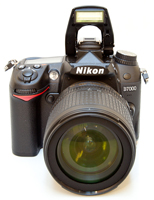 | 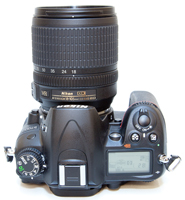 |
| Pop-up Flash | Top |
One area of photography that the D7000 is particularly well suited to is flash photography. The camera has a built-in speedlight with a guide number of 12 (in metres) at ISO 100. In auto mode, this flash will pop-up automatically if the camera thinks it's necessary, but in most other exposure modes, it is left to the photographer to decide whether to use it or not. This little flash can not only be used as an emergency light source or a fill light, but also as a commander for up to two groups of wireless flash units. In such a setup, you can specify if you want the on-board flash to give only a signal to fire off the wireless slaves or also to provide some fill light. It is also possible to chose the mode of operation (TTL, Auto or Manual) for one or both of the slaved flash groups, and even to regulate their output from the camera. Compatible flashguns include the SB-900, SB-800, SB-700, SB-600, and SB-400 flash units.
As with most recent DSLR cameras from both Nikon and the other manufacturers, the D7000 offers Live View off the main sensor. Live View has its own dedicated spring-loaded switch on the rear of the camera. Move it to the left and the mirror flips up, the shutter opens and the rear screen displays the scene as seen through the lens. Live View is either delivered on the high-resolution rear monitor or on any LCD panel or plasma screen connected to the camera via an HDMI cable. There is a red rectangle in the middle for focusing , which you can move practically anywhere in the frame. When in manual focus mode, you can magnify into this rectangle in five steps simply by repeatedly pressing the button marked with a loupe icon, but this magnification seems to be interpolated rather than real. This means that you cannot see detail down to the pixel level, unlike with many competing cameras, which was a disappointment given the excellent LCD screen.
Manual Focus is not the only focusing option in Live View when taking still images. The D7000 has two AF modes in Live View, AF-A and AF-F. Both employ a contrast-detect method of focusing, with AF-A locking onto the subject when you half-press the shutter button, and AF-F (full-time-servo AF) automatically tracking the subject continuously even if it moves. The D7000's Live View auto-focusing isn't very fast, typically taking between 1 and 2 seconds to lock focus on a subject in good light, and eben longer in low-light conditions. There are selectable AF-area modes according to the subject; face-priority AF, wide-area AF, normal-area AF and subject-tracking AF. 'Face-Priority AF' had no problem finding and keeping track of human faces as long as they were facing the camera, and the system can detect up to 35 faces and will attempt to focus on the one closest to the camera.
The amount of overlaid information is user selectable, and can include a shooting grid similar to what you can see in the optical viewfinder and also the new virtual horizon which helps to keep your images straight. This feature can also be turned on and off via the reprogrammable Fn button, which can be assigned to a range of different functions, and also appears in the optical viewfinder status bar via the exposure compensation scale. But there's still no live histogram, as on the D90, which is a glaring omission that makes Live View much less usable than it could be, and again puts Nikon behind the competition in this area. Photographers who intend to use Live View mainly for tripod work will, on the other hand, be delighted to learn that the camera offers true mirror lock up
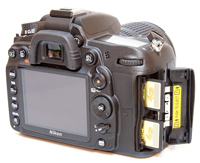 | 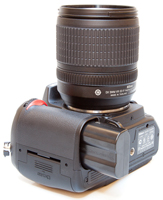 |
| Top | Bottom |
Live View is also employed by the Nikon D7000's movie mode. After moving the Lv switch to the left and optionally presetting the aperture, shutter speed and focus, you can start recording video by pressing the Movie button with the red dot sitting within the Lv switch. The camera records full high-definition, wide-screen video in 1920x1280 pixel resolution, at a frame rate of 24fps, in AVI format using the motion JPEG codec. As with Live View, contrast-detect AF is possible whilst shooting movies, although as with still images there's an audible whine as the camera refocuses and it's still too slow to focus on any fast-moving subject, so much so that we suspect most serious users will use manual focusing instead. Although the D7000 can automatically focus during video recording, the first DSLR to do so, it's just not fast enough to warrant regular use or to rival cameras like the Panasonic Lumix GH1/2.
You can set both the aperture and the shutter speed from the camera in movie mode, although the slowest shutter speed is limited to 1/30th second, plus exposure compensation and AE-Lock can also be set. Out of the box the D7000 can only record monaural sound via its built-in microphone with three different levels of sensitivity on offer, but stereo recording can be recorded using an optional external microphone. The maximum size of a single video clip is 2 gigabytes which, given that movies occupy about 100 megabytes of storage space per minute, would theoretically translate into about 20 minutes of continuous recording, but – apparently because of certain legal regulations in the EU –, Nikon decided to limit the clip length to 5 minutes for high-definition movies.
For the images already captured, the Nikon D7000 offers a broad range of retouching tools, including post-capture D-lighting (useful if you forgot to turn on Active D-lighting before capture), red-eye correction, trimming, monochrome conversion, different filter effects, colour adjustments, image resizing, image overlay, in-camera raw processing, quick auto retouching, straightening of crooked pictures, lens distortion correction, perspective control (reduction of keystoning), and new fisheye, miniature, colour outline and colour sketch effects. Many of these functions make it unnecessary to buy specialised computer programs or plug-ins and spend hours in front of a computer to achieve a desired/popular effect. Interval timer shooting is a powerful feature and something that isn't offered by the D90. Check out our article on time-lapse photography in our Techniques section to get an idea of what you can use this feature for.
As far as connectivity goes, there are USB / VideoOut and Mini HDMI ports as well as an accessory terminals for the connection of an external microphone and either wired remote or a GPS unit, all sheltered behind two rubberised doors on the left side of the camera, when viewed from the back.

No comments:
Post a Comment